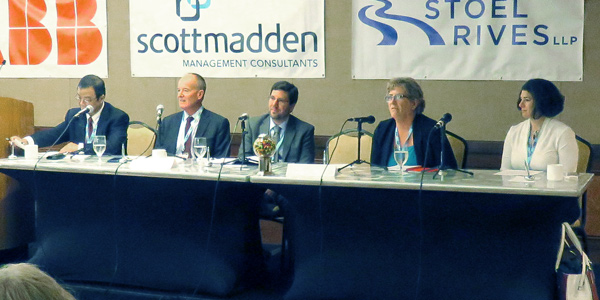By Jason Fordney
SAN DIEGO — The CAISO-run Western Energy Imbalance Market (EIM) has increased the operational flexibility of the region’s utilities and is leading to changes in resource procurement in states outside California, utility representatives said last week.
Speaking on a panel at Infocast’s Transmission Summit West, Matt Lecar, Pacific Gas and Electric principal of ISO relations and FERC policy, said “one of our big challenges is managing solar generation, and the EIM has been extremely valuable” by absorbing generation and reducing curtailment of renewables.

Left to right: Panel Moderator Tao Guo, Consultant ABB; Fuller, Lecar, Park, Rosenblatt | © RTO Insider
“We get to use more of our clean energy, more of the time,” Lecar said.
The EIM is also serving as a “proving ground as to how create a governing structure for a regional RTO,” he said, creating more planning certainty for entities in the West.
“The key here is to develop a culture of trust,” he said, adding that the EIM is proving the benefits of a regional market, and “the biggest enemy of trust is uncertainty.”
Even though the EIM is presently only a balancing market, it is already having an effect on resource planning in other states, NV Energy Director of Energy Market Policy Lauren Rosenblatt said.
“Now Nevada is highly affected by the regional resource mix in ways it wasn’t before,” she said. Nevada gets a lot of negatively priced solar energy from California, so power suppliers are less likely to build solar photovoltaic because they have the opportunity to obtain solar output from next door.
Idaho Power Vice President of Power Supply Tess Park said it is a positive that the EIM doesn’t require a participant to stay in the market for years, and if things don’t go well, “there is an out.”
The EIM has grown since its launch in November 2014, and panel participants said it has allowed energy resource-rich areas in the western interior to more effectively link up with the load-heavy population centers on the California coast. CAISO said the EIM produced $39.52 million in benefits for its participants in the second quarter, with CAISO gaining the largest share. (See CAISO Leads EIM Q2 Benefits, Exports.) As of the end of the second quarter of this year, benefits have been $213 million from more efficient dispatch, reduced renewable curtailment and reduced need for flexible ramping capacity, the ISO has said.

Portland General Electric joined the EIM on October 1 | CAISO
CAISO Strategic Alliance Director Don Fuller said the EIM has brought better economics and resources to electricity sector participants in the West. By taking advantage of excess capacity on the existing transmission system, the EIM helps avoid building of new transmission lines and makes for a more efficient regional grid.
“The idea was to take advantage of unused transmission, so it worked without new transmission,” Fuller said, adding that as new market participants bring transmission in, it helps all EIM entities move energy around.
The EIM took advantage of CAISO’s existing market platform and allowed easy entry and exit, allowing individual balancing authorities to retain control over their assets and join when they wanted. That has been a “key factor” in its growth, he said.
The market “has been another tool in our effort to manage renewables” and allows neighboring states to take advantage of low-cost power being produced in California, Fuller said.
Portland General Electric on Oct. 1 became the latest utility to begin operating in the EIM, and others have agreed to join but have not yet begun participating. Active participants include PacifiCorp, NVE, Puget Sound Energy and Arizona Public Service. Idaho Power and Powerex are due to join in 2018; Seattle City Light, the Los Angeles Department of Water and Power, and Balancing Authority of Northern California in 2019; and Salt River Project in 2020.


